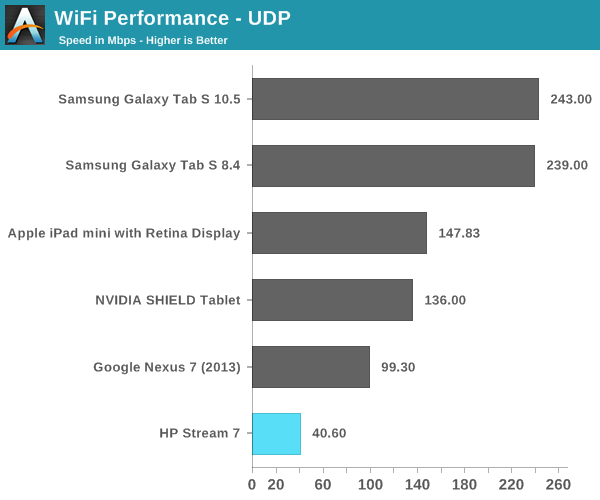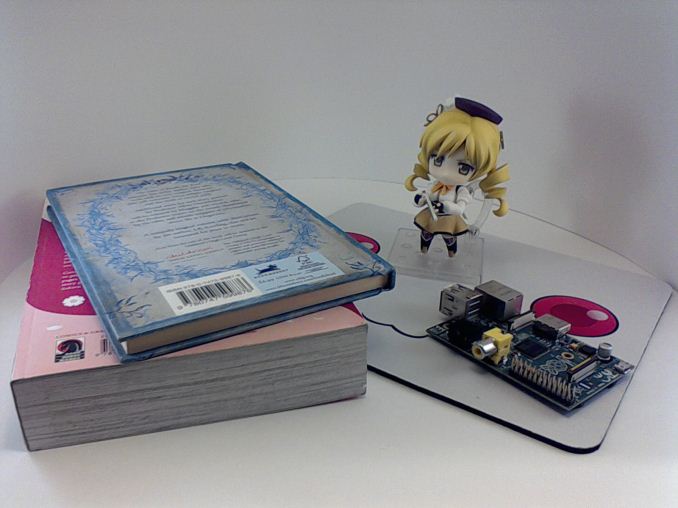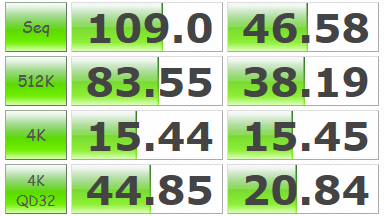HP Stream 7 Review: A $119 Windows Tablet
by Brandon Chester on December 19, 2014 8:00 AM ESTCamera
It looks like including a camera is now a requirement for pretty much any device, and so even the Stream 7 has a front-facing and a rear-facing camera. In the Windows device manager, the front camera identifies itself as "Camera Sensor GC310". I haven't been able to find any information about it, but the image quality leads me to believe that it may be best for people to not know where it came from. The rear camera idenitifes itself as HM2056, which I was able to find information about. It's made by a company called Himax Imaging, and if you haven't heard of them it's okay, because I hadn't either. It's a 2MP 1/5" sensor, which translates to 1.75 micron pixels. It has no auto focus, and that combined with the specifications leads me to believe that this is normally intended to be a front-facing sensor.
As you can see, the output is really bad. The text on the back of the books is illegible, most detail is lost, and there's noise everywhere. It's just honestly not a good camera, and it's something I would only use as a last resort. It's somewhat annoying that HP felt the need to even put a rear camera on the Stream 7, as it adds to the BOM and the money could have been better used on something like a larger battery.
NAND
I mentioned earlier that the Stream 7 doesn't even have enough storage to fit PCMark 8 and some of the other benchmarks we use. Out of the box, you get around 18.5GB free. This means that we can't run our typical Windows storage benchmarks, so I've used CrystalDiskMark to get an idea of how the storage performs.
I wouldn't try making direct comparisons between this and our storage benchmarks on Android and iOS, but it's still able to give you an idea of what you can expect. The Stream 7 uses Samsung's MGB4GC eMMC solution, so we can't expect the same storage performance that you get from Windows devices with a full blown SSD. The read and write performance ends up being pretty good for an eMMC solution, although I'm suspicious of the 4k random write result considering how even the best eMMC solutions we've seen in Android and iOS tablets top out around 3MB/s.
WiFi
The HP Stream 7 uses a Realtek RTL8723BS solution for WiFi and Bluetooth. This is a single spatial stream 802.11n part, with no 5GHz support and only 20MHz channel width. That means that we're dealing with a theoretical maximum speed of 72Mbps. In real world use, it's quite a bit less, as you can see below.

Again, at $119 this is expected and can be excused. Faster WiFi would be nicer, but it's not free. My only complaint about this speed in the real world is that the slow WiFi makes it difficult to move large files over the network onto the Stream 7. This wouldn't be an issue if these Windows tablets allowed you to directly move files to them from another computer over USB, but they don't. I've also encountered issues with the WiFi disconnecting intermittently, which is incredibly frustrating when it means you have to begin transferring a large video from the beginning. I've contacted HP about this to see if they're aware of this issue, as I've seen complaints about it from other users, but I haven't received a response.
Misc
I am unfortunately not equipped to do objective audio testing on the Stream 7. It uses Realtek's audio codec, and so it isn't likely to be anything exceptional. The bottom mono speaker is adequate; there's not much to be said about it. Unfortunately, everything comes crashing down when you try to use the 3.5mm jack. Even if the Stream 7 had the best audio solution in the world, it would be crippled by this defect that I cannot believe made it to production.
Essentially, the 3.5mm jack has a great deal of noise and static, and it makes it effectively unusable. I have confirmed this with two other owners, and there are complaints about it on the web. It's likely that there's an insufficient amount of shielding for the audio port and PCB connections, and it's extremely disappointing. With its support for all the great video players on Windows, the Stream 7 could have been an inexpensive and powerful video player. But unless you're going to use the built-in speaker or Bluetooth headphones/speakers, there's no way to listen to audio on this tablet. When I reached out to HP about the WiFi connection issues I also asked about this, but again I haven't received a response.


















157 Comments
View All Comments
pugster - Friday, December 19, 2014 - link
I brought one of these tablets for $70 this week actually after a couple of promos from Microsoft. I wish that they had included an dongle where you can plug in an usb drive in it and an hdmi port. I have windows 8 pc's and using this windows 8 tablet is definitely a learning curve compared to Android tablets and ipads. I was surprised that windows 8 with 1gb of ram is responsive in this tablet assuming that you won't multitask that much.Since Microsoft gives out these windows 8.1 with bing licenses for free, I would imaging that we would see many Chinese tablets to get into this bandwagons for cheap tablets next year.
swkerr - Friday, December 19, 2014 - link
I actually bought 2 of these of the kids for Christmas. One at $99 and one for $74 from the Microsoft store. I have been using a Nexus 7 second Gen for more than a year and have found it to be the perfect size. It is really just a glorified reader and Alarm clock. I use it to read the news and check email and occasional light gaming but never video or music.I figured for this purpose the Stream 7 would be fine and anything else was just a bonus. The Office subscription is a big plus as well. I have already set them up and tested them and am actually very impressed. I actually purchased a case ($10) Mini Bluetooth Keyboard with touch-pad ($30) and a 64GB MicroSD card ($25)
As setup I was able to install Sims4 and Origin and the game actually plays pretty good. I installed Steam and The Swapper on the other and again works fine. Some of the Windows games are not bad either.
Flipboard, Facebook and Twitter all work well as well as Nexflix, Hulu and Plex. Alarm Clock HD + was the best Alarm clock app I could find and it works great. Not sure I would ever use office on one of these without the Bluetooth keyboard but with the keyboard it would work fine in a pinch.
I have a Microsoft Wireless Miracast dongle on my TV and the Stream 7 works perfectly with it. Even at the low resolution it looks pretty good streaming from Netflix. I was able to get it to run at 1080p as well but then you need the bluetooth keyboard.
If you think of this thing as a PC it sucks but as a 7 inch table it really does what you expect of it and at $99 it is a bargain. The Metro app store is limited but the basic crap people really use is there. And if it is not you still have a browser and all the old PC apps that will probably run fine. The lack of touch support on the old games and apps may be an issue and some things don't size will to the low resolution but for what you are likely to use it for it is great.
Was considering buying another Nexus 7 in case I broke my current one but would probably get one of these instead. I have several 10" Transformer tables and They are just too big for how I use a tablet. Even the 8" android and iPad Mini are just that much too big as a reader.
CharonPDX - Friday, December 19, 2014 - link
"This wouldn't be an issue if these Windows tablets allowed you to directly move files to them from another computer over USB, but they don't."But they do. The micro USB port supports the "USB OTG" (USB On-The-Go) specification. With a simple adapter, the port can be converted to a full-size USB Type-A port, to which you can plug in whatever USB devices you want. (That's the extra bonus of it running full Windows 8.1.) I have used my HP Stream 8 with a variety of USB devices.
Note: The Stream 8 is different than the Stream 7 in only three ways that I can find:
1. It has a 1" larger screen (8" instead of 7", but with the same quality of screen.)
2. It includes 4G wireless (HSPA+, aka "3.5G" to most of us,) with 200 MB per month free form T-Mobile. I have T-Mobile for my family, so I just pay the $10/month to duplicate the amount of data on my highest-data line.)
3. It costs $179. (Which is a steal - since it costs $139 just to *ADD* 4G to an iPad.)
Brandon Chester - Friday, December 19, 2014 - link
Out of the box you can't do it, which is what matters.PC Perv - Friday, December 19, 2014 - link
Why not? All you need is a right cable. I am sure one will find such a cable for a lower price than Apple's Lightning cable's.You are such an ignorant and arrogant creature. Though I know why you want to disregard the utility of USB OTG. Which makes you a crooked creature on top of the aforementioned.
CharonPDX - Monday, December 22, 2014 - link
Really? Then no desktop computer should ever have its utility on the internet considered since it doesn't come with internet built-in (you need SOME form of internet connection!)No printer should ever be considered worth using, because it doesn't come with paper in the box.
A USB on-the-go cable costs all of $1.47 at Monoprice.
I'm sorry, but that being your answer to my statement makes me seriously downgrade my judgment of you. Had you replied "I had forgotten about USB On-The-Go," I would have given you plenty of slack. But to completely dismiss an actually available core function completely, simply because "you can't do it out of the box," is rather haughty and dismissive.
My Xbox is a crappy game system when it doesn't come with any games in the box.
Using a USB On-The-Go adapter, you're limited to USB Hi-Speed speeds, but my USB 3.0 128 GB flash drive works just fine, and is plenty fast. In fact, it's almost certainly faster than the internal eMMC SSD. (Copying large files from eMMC to USB gets me about 27 MB/s. Copying large files from the USB to the eMMC is about 30 MB/s.) PLENTY fast to transfer large files.
Brandon Chester - Friday, December 26, 2014 - link
It would be fine if the ability to send files from a PC via a direct USB connection was not an expected ability for a tablet, but it is. Alternatively, HP could have used faster and more stable WiFi and it would be a non-issue. Ferrying files between the two devices with a USB drive is a time consuming and cumbersome process, and having to go get additional hardware for it is an additional hurdle. I actually don't live near any electronics stores, so I would either need to drive a significant distance to get a USB-OTG adapter, or I would have to pay for one and have it shipped which takes time and reduces the tablet's price appeal, especially when paying shipping fees here in Canada.CharonPDX - Friday, December 19, 2014 - link
Mini related review:I bought the Stream 8, which is 1" larger, and includes HSPA+ "4G" service, for $179. My findings are near-identical to this review. The battery life is longer, and the back of the device fits better than Brandon describes the 7, but otherwise it seems the same to me, right down to the headphone jack noise issue. (I use Bluetooth headphones, so I mitigate that.)
In the past year, I have switched between an iPad Air, a low-end Android tablet (the Air became my daughter's tablet,) to the HP Stream 8. I like the Stream 8 the best - even better than the iPad Air (and I was a 100% Apple user for personal devices prior.) I REALLY like having full-blown Windows available to me when I need it. I carry a small Bluetooth keyboard and mouse with me (Microsoft Wedge Mobile keyboard,) when I need to use it as a "real computer" rather than a tablet.
The cellular connection is a nice bonus over the 7" model - and while the T-Mobile "free 200 MB per month for the life of the device" isn't much data, but it is a nice "lifeline" for emergencies. (I have a T-Mobile family plan, so I just added it to my family plan for $10/month.)
bill.rookard - Friday, December 19, 2014 - link
Just as a quick note, maybe I got lucky. I'm watching Guardians of the Galaxy right now through headphones with absolutely no static issues whatsoever.CharonPDX - Monday, December 22, 2014 - link
I haven't listened to headphones often after the first couple times being static-driven. I was using Apple EarPods (because they're my standard "desk" 'phones at work.)I have now tried a few more, and the EarPods are the noisiest. Headphones that don't also have a microphone are the best, with some old-school Sony Studio Monitors (which are generally my best-sounding headphones every time,) having the lowest noise, but still having some.
The Sonys, and a couple of the other "no microphone" ones are quiet enough that I can only hear the static during silent/very quiet periods.